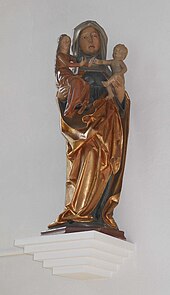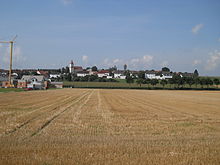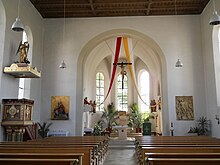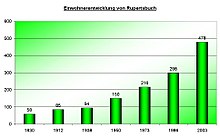Rupert's book
|
Rupert's book
Municipality Schernfeld
Coordinates: 48 ° 55 ′ 34 ″ N , 11 ° 8 ′ 27 ″ E
|
|
|---|---|
| Height : | 548 (530-551) m |
| Residents : | 478 (2003) |
| Postal code : | 85132 |
| Area code : | 08421 |

Rupertsbuch is part of the municipality of Schernfeld in the Upper Bavarian district of Eichstätt .
location
The place is located on the plateau of the southern Franconian Alb north of the Altmühltal on the B 13 between Eichstätt and Weißenburg in Bavaria .
history
The place Rupertsbuch (Ruotpoldespuoch, ie beech forest of the Ruotpold) is 1002 when the wild bans were granted by Emperor Otto III. first mentioned in a document. In 1289 the Eichstätter Bishop received an estate in Rupertsbuch from the last Hirschberg Count Gebhard VII. In 1347, the Eichstätter Bishop Albrecht I von Hohenfels bought the localities Rupertsbuch and Workerszell from the Counts of Oettingen . In the period from 1338 to 1440, the two villages belonged to the Lords of Heideck . In 1443 they were bought back by the Eichstatt Bishop Albrecht II von Hohenrechberg . Rupertsbuch, consisting of seven subjects (families), was subject to the Mörnsheim caste office until secularization with regard to village and community rulership , and the Dollnstein nursing office at high court . The Eichstätt Hospital also owned land in Rupertsbuch.
From Palm Sunday to Good Friday in 1460, the enemy army of the dukes of Bavaria-Landshut , who at that time were at war with the Eichstätt bishop , camped nearby. The entire area was looted.
In 1486, the Eichstatt Bishop Wilhelm von Reichenau exchanged goods in Rupertsbuch with the Augustinian Canons Rebdorf .
In 1808 Rupertsbuch formed together with Sappenfeld , Schönau and Schernfeld with Harthof the tax district Schernfeld. Rupertsbuch has belonged to the Workerszell community since 1818 , including the Ferdinandshof , the former ducal Geländer stud and the Sperberslohe estate . In 1910 the water tower - no longer used as such today - was built in Rupertsbuch. It has a height of 25 m and a capacity of 100 m³.
The First World War also claimed victims in the Rupertsbuch parish in 1918. 85 people are called to arms, 19 of whom never returned home.
After the end of the Second World War in 1945, a terrible balance had to be drawn: 145 parishioners were called up for military service, 24 fell, 12 went missing, 2 died in Russia and 4 at home as a result of their war injuries.
On May 1, 1978, the community of Workerszell with the districts of Workerszell, Rupertsbuch, Langensallach, Sperberslohe, Lohrmannshof and Petershöhe was incorporated into the community of Schernfeld.
The Catholic parish of Rupertsbuch
After some notes it can be concluded that there was a pastor and a rectory in Rupertsbuch / Workerszell in 1450. In 1749, Johann Anton II , Bishop of Eichstätt, founded the Rupertsbuch parish, separated from the Marienpfarrei (Collegiata) in Eichstätt, with Count Sigmund Christoph von Schrattenbach , canon in Salzburg, Eichstätt and Augsburg, acting as benefactor. In 1750 the rectory was built. Five years later the St. Anna Brotherhood was founded. In 1757 the first pastor of the new parish "Roppersbuch", Johann Martin Eberhard, died.
In 1860 a new school and sacristan's house was built, which was replaced in 1926 by a new and larger school house with 2 classrooms. This was demolished around 1991 - after a brief successor use as a kindergarten. In 1985 the new building of a youth home in the parish garden was completed. In 1994 the parish's new kindergarten was opened.
1916–1946 Johann Baptist Brand, 1946–1984 Alfons Girbinger and 1984–1993 Josef Bierschneider was pastor of Rupertsbuch. Franz Remberger has been in office since September 1, 1993.
Catholic Parish Church of St. Michael
In 1683/84, Jakob Engel renovated the dilapidated church. On September 3, 1896, at 2 a.m., the church tower burned down completely. The bells fell, the church clock was destroyed. An apprentice of the locksmith Bayerschmitt had kept the soldering furnace in the tower that evening. On September 27, 1897 Pastor Michael Seitz laid the foundation stone for the new building of today's neo-Romanesque church; the tower, the basement of which dates from the Middle Ages and which formerly contained the choir, was also used. In 1901 the new organ with 12 registers was installed by the Bittner Organ Builders, Eichstätt. In 1903 the history painter Lang, Munich, and Luxenhofer, Neumarkt, painted the church in the Nazarene style. In 1950, four new bells were purchased and consecrated for the parish church. In 1955 the interior of the church was restored. In the parish church there is the Jura marble relief of a mercy seat , a votive offering from Eichstätt Bishop Moritz von Hutten from 1551, created by Loy Hering after a wood engraving by Albrecht Dürer . It was originally located as the center piece of the altar in the collegiate parish church (today Volksbank) in Eichstätt, which was demolished in 1818. The Bittner organ was dismantled in 1999 and a new organ from the organ building company Redeker and Kreuzer from Munich was installed. In 2003 new pews were installed.
Population development
Others
- In 1953 the rifle club "Jurahöhe" Rupertsbuch was founded.
- Church associations include the Catholic rural youth movement (KLJB) and a branch association of the Catholic German Women's Association (KDFB)
- The warrior u. Rupertsbuch's Comradeship Association celebrated its 50th anniversary in 1974.
- In 1986 the new war memorial was consecrated .
- To the south of Rupertsbuch, a corridor chapel on the edge of a wood reminds of the abandoned village of Wickenzell , which existed until around 1548 and consisted of three courtyards and a chamber fief of the Augustinian canons of Rebdorf . According to a memorial stone inside, two girls from these courtyards are said to have been murdered at today's chapel.
literature
- Rupert's book. In: Felix Mader (editor): The art monuments of Bavaria - Middle Franconia. II. Eichstätt District Office. Munich 1928 (Reprint Munich and Vienna 1982), pp. 307–309, panel XXII.
- Theodor Neuhofer: Ruperts book. In: Collective sheet of the historical association Eichstätt 61 (1965/66), Eichstätt 1968, p. 34.
- Rupert's book. In the Eichstätter Raum past and present. Eichstätt, Sparkasse, 2nd expanded edition 1984, p. 276.
Web links
Individual evidence
- ^ Federal Statistical Office (ed.): Historical municipality directory for the Federal Republic of Germany. Name, border and key number changes in municipalities, counties and administrative districts from May 27, 1970 to December 31, 1982 . W. Kohlhammer, Stuttgart / Mainz 1983, ISBN 3-17-003263-1 , p. 599 .






